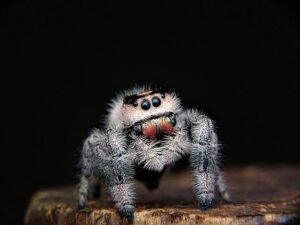Jumping Spiders
If there’s one animal that can cure arachnophobia, the irrational fear of spiders, then it’s the cute jumping spider. This adorable spider family has everything you want in cats and dogs: They can be tamed (that’s exaggerated, but they lose the fear of their owner), they’re fluffy, and they have four pairs of eyes. They’re real cuties, and it’s not a big surprise that keeping jumping spiders as pets has become a new trend.
But how dangerous are jumping spiders to humans? Are they venomous? Can jumping spiders kill you? How smart and how harmful are they? What do they eat, and is it true that if you have a jumping spider bite, you will turn into a superhero who jumps from roof to roof and hunts down criminals? Here are the facts!

Are jumping spiders venomous to humans? Can they hurt or even kill you?
Jumping spiders are friendly, a bite uncommon and not dangerous to humans, and most can’t even penetrate human skin. They produce venom and are, like most spiders, minimally venomous but rarely bite in self-defense – their natural reaction when in danger is to run or jump away.
A jumping spider bite’s symptoms are pain, itching, swelling, and skin redness, comparable to a mosquito bite.
Are jumping spiders poisonous to dogs and cats?
No, they’re not considered poisonous to dogs or cats. Their venom is used to immobilize small insects, not much bigger than the spider itself. Like humans, a jumping spider bite may cause itching and swelling of the skin in dogs and cats. And just like with humans, most spider bites can’t penetrate the skin of a dog or cat. Of course, when in doubt, consult a veterinary.
What do jumping spiders look like?
Jumping spiders do have 8 eyes, two large ones and two small ones on their face, plus two pairs on their heads. Their body length, depending on species, varies between 0.04 and 0.98 inches (1 to 25 mm). Salticidae have two fangs and hunt without a net. They often look furry, which is one more reason why they’re the most adorable spider family.

Why do jumping spiders wear water droplets?
They don’t! Jumping spiders don’t wear water droplets as a hat in the wild. If you find pictures showing them wearing a water hat, it’s probably staged by a photographer.
Eyes And Vision
All jumping spiders have eight eyes. Two pairs are on their face and 2 pairs on their head, giving them nearly a 360° view of their environment. They have a better vision than most other spider families.
Why you shouldn't Kill Spiders
Jumping Spiders are carnivores and hunt down small pests in your house, including Flies and Mosquitoes, Cockroaches, Earwigs, and Moths. Some Spiders are cannibals and even eat other spiders.
Can you keep jumping spiders as pets?
Yes, some people keep Jumping spiders as pets because they’re friendly, smart (compared to other spiders), and cute. Even though they can be tamed and lose their fear, they’re not affectionate to their owner.
What do jumping spiders eat? The jumping spider diet!
Most species are carnivores and hunt small insects, including grasshoppers and crickets, and pests like Flies, Mosquitoes, Cockroaches, Earwigs, Moths, and even other Spiders. Some species, however, also include nectar in their diets.

How to feed a pet jumping spider?
If you keep a jumping spider as your pet, mealworms, flies, and waxworms are best. You can buy “Drosophila hydei” or “Drosophila melanogaster” from a pet store and breed them at home in a small box or tube. Both fly species are incapable of flying with a short lifespan and have a high nutritional value for jumping spiders.
What's a good Jumping Spider Enclosure?
It depends. If you want to keep a jumping spider as a pet, you should imitate its natural environment. This depends from species to species. You can get enclosures made for spiders in many pet stores.
Jumping Spider Habitat
Most species live in tropical forests, but you can find jumping spiders almost all over the world. Depending on species, they can be found in deserts, forests, and one species on Mount Everest.

Of Dancing Spiders - Mating Behavior
Jumping spiders dance to attract females. Yes, really! It’s quite an impressive performance. They dance in smooth zigzag moves, jump around, wave their legs around, and the more seductive the dance, the more likely she is to accept his proposals. In fact, the female will try to hunt and kill the male spider while he’s moving around.
It might be his last dance if he doesn’t get his moves right. But once the act is over, the female kills and eats the male spider anyway – for his nutritional values! Well, at least he won’t suffer from her complaints while she’s pregnant.
How And Why Do They Jump?
As the name suggests, Salticidae can jump pretty well. They mainly jump to hunt when there is danger or to seduce females. Salticidae uses their rear legs to jump by explosively stretching their legs. That way, even without well-developed muscles, the spider can jump its own body length many times with just one jump.
Jumping Spiders Facts In a Nutshell
- There are 600 described genera and over 6000 described species in the Jumping spider family
- Have 4 pairs of eyes and a strong vision
- Rarely bite humans
- Their bites hardly penetrate human skin
- Exist all over the world – but most species can be found in tropical forests
- Are active hunters and don’t build a net
- Have an excellent vision compared to other arthropods
- Eat small insects, like grasshoppers and crickets, Flies, Mosquitoes, Cockroaches, Earwigs, Moths and other Spiders
- Can jump by explosively stretching their legs
- Dance to seduce females
- Don’t wear water droplets as hats
- Females kill and eat males after mating
- Use their spider silk to build cocoons for their eggs, but not to hunt.
